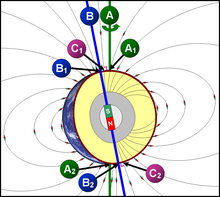Geographical pole
point of intersection of a celestial body’s surface and its rotational axis
A geographical pole is either of two points on the surface of a rotating planet where the axis of rotation meets the surface of the planet. The north geographical pole of a body is 90 degrees north of the equator. The south geographical pole lies 90 degrees south of the equator.[1]

Relative to Earth's surface, the geographic poles move by a few metres over periods of a few years.[2]
As cartography requires exact and unchanging coordinates, the average positions of the geographical poles are taken as fixed. These cartographic poles become the points where the body's great circles of longitude intersect.
Related pages change
References change
Wikimedia Commons has media related to Geographical poles.
- ↑ "Magnetic North Pole vs. Geographic North Pole". Archived from the original on 2008-12-31. Retrieved 2015-12-29.
- ↑ Lovett, Richard A. (14 May 2013). "Climate change has shifted the locations of Earth's North and South Poles". Scientific American. Retrieved 6 January 2019.